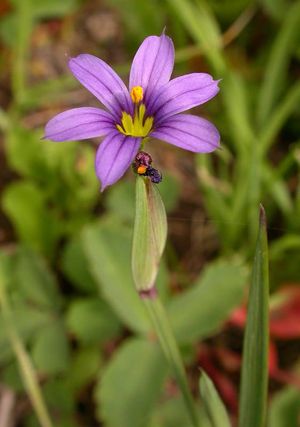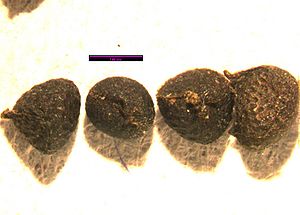Difference between revisions of "Sisyrinchium idahoense"
(→Photo Gallery) |
|||
| Line 1: | Line 1: | ||
| − | |||
*Scientific Name: ''Sisyrinchium idahoense'' | *Scientific Name: ''Sisyrinchium idahoense'' | ||
*Family: Iridaceae | *Family: Iridaceae | ||
*Common Names: blue-eyed grass, Idaho blue-eyed grass | *Common Names: blue-eyed grass, Idaho blue-eyed grass | ||
*Codon: SISIDA | *Codon: SISIDA | ||
| − | ==Taxonomy== | + | ---- |
| + | [[File:SISIDA8.jpg|thumb|Photo by Ben Legler, 2004, also featured on Main Page]] | ||
| + | ===Taxonomy=== | ||
{{Taxobox | {{Taxobox | ||
| − | | name = | + | | name = |
| regnum = [[Plant]]ae | | regnum = [[Plant]]ae | ||
| subregnum = Viridiplantae | | subregnum = Viridiplantae | ||
| Line 20: | Line 21: | ||
}} | }} | ||
<ref>Integrated Taxonomic Information System. Retrieved from https://www.itis.gov/servlet/SingleRpt/SingleRpt?search_topic=TSN&search_value=43266#null</ref> | <ref>Integrated Taxonomic Information System. Retrieved from https://www.itis.gov/servlet/SingleRpt/SingleRpt?search_topic=TSN&search_value=43266#null</ref> | ||
| − | ==Description== | + | ===Description=== |
Showy, tufted perennial to 40 cm tall; stems usually flattened and wing-margined. Leaves mostly basal, long (to 20 cm.) and very narrow (< 2 mm broad). | Showy, tufted perennial to 40 cm tall; stems usually flattened and wing-margined. Leaves mostly basal, long (to 20 cm.) and very narrow (< 2 mm broad). | ||
| Line 31: | Line 32: | ||
State College Press.</ref> | State College Press.</ref> | ||
| − | ==Bloom Period== | + | ===Bloom Period=== |
March to June | March to June | ||
| − | ==Distribution== | + | ===Distribution=== |
Both ''S. i.'' var. ''occidentale'' (outer tepals 8-13 mm, inner spathe 12-20mm; spathe keel margins entire) and ''S. i.'' var. ''segetum (''outer tepals 10-17 mm; spathe keel margins generally denticulate) have been reported in the South Salish Sea region. <ref>Hitchcock, C. L., Cronquist, A., Giblin, D., & Legler, | Both ''S. i.'' var. ''occidentale'' (outer tepals 8-13 mm, inner spathe 12-20mm; spathe keel margins entire) and ''S. i.'' var. ''segetum (''outer tepals 10-17 mm; spathe keel margins generally denticulate) have been reported in the South Salish Sea region. <ref>Hitchcock, C. L., Cronquist, A., Giblin, D., & Legler, | ||
B. et al. (2018). ''Flora of the Pacific Northwest: an illustrated manual''. | B. et al. (2018). ''Flora of the Pacific Northwest: an illustrated manual''. | ||
Seattle: University of Washington Press.</ref><ref name=":0" /> | Seattle: University of Washington Press.</ref><ref name=":0" /> | ||
| − | ==Habitat== | + | ===Habitat=== |
| − | ===Ecological Setting=== | + | ====Ecological Setting==== |
Moist to wet grassy meadows, vernal seepage areas, marshes, roadside ditches; at low to middle elevations <ref name="Pojar" /> | Moist to wet grassy meadows, vernal seepage areas, marshes, roadside ditches; at low to middle elevations <ref name="Pojar" /> | ||
| − | ===Soil Texture=== | + | ====Soil Texture==== |
Fine to well-drained. | Fine to well-drained. | ||
| − | ===Soil Reaction / Salinity=== | + | ====Soil Reaction / Salinity==== |
Mildly acidic to alkaline (pH 5.5 to 7.5) <ref name="Henderson">Henderson, 1976</ref> | Mildly acidic to alkaline (pH 5.5 to 7.5) <ref name="Henderson">Henderson, 1976</ref> | ||
| − | ===Shade Tolerance=== | + | ====Shade Tolerance==== |
Full sun to partial shade <ref name="Tenenbaum">Tenenbaum et al., 1994</ref> | Full sun to partial shade <ref name="Tenenbaum">Tenenbaum et al., 1994</ref> | ||
| − | ===Successional Status=== | + | ====Successional Status==== |
Considered a "weedy" species and a good early secession species after disturbance. <ref name="Alverson">Alverson, 2002</ref> | Considered a "weedy" species and a good early secession species after disturbance. <ref name="Alverson">Alverson, 2002</ref> | ||
| − | ==Uses== | + | ===Uses=== |
| − | ===Site Rehabilitation=== | + | ====Site Rehabilitation==== |
Possible reclamation species in moister pockets in selected sites <ref>Winters, 2002</ref> | Possible reclamation species in moister pockets in selected sites <ref>Winters, 2002</ref> | ||
| − | ===Wildlife=== | + | ====Wildlife==== |
Solitary bees of the family Megachilidae are mainly responsible for cross-pollination in natural populations. <ref name="Henderson">Henderson, 1976</ref> | Solitary bees of the family Megachilidae are mainly responsible for cross-pollination in natural populations. <ref name="Henderson">Henderson, 1976</ref> | ||
| − | ===Landscaping=== | + | ====Landscaping==== |
Mass-plant to create a showy display in a border or a rock garden <ref name="Tenenbaum" /> | Mass-plant to create a showy display in a border or a rock garden <ref name="Tenenbaum" /> | ||
| − | ==Propagation== | + | ===Propagation=== |
| − | ===Seed Propagation=== | + | ====Seed Propagation==== |
Flowers are protandrous, thereby promoting out-crossing and at the same time reducing the chances for self pollination. S. idahoensis is an octoploid species and often exhibits a lag of up to 24 hours between anther maturation and stigma receptivity <ref name="Henderson" /> | Flowers are protandrous, thereby promoting out-crossing and at the same time reducing the chances for self pollination. S. idahoensis is an octoploid species and often exhibits a lag of up to 24 hours between anther maturation and stigma receptivity <ref name="Henderson" /> | ||
====Fruit and Seed Collection and Extraction==== | ====Fruit and Seed Collection and Extraction==== | ||
| Line 70: | Line 71: | ||
Seal seeds in a Ziploc-style bag or a Rubbermaid-style container in equal amounts of seed to perlite or vermiculite, and add just enough water to moisten the mixture. Cold stratify at 5º C for 8 to 12 weeks <ref name="Schultz" /> | Seal seeds in a Ziploc-style bag or a Rubbermaid-style container in equal amounts of seed to perlite or vermiculite, and add just enough water to moisten the mixture. Cold stratify at 5º C for 8 to 12 weeks <ref name="Schultz" /> | ||
| − | ===Outplanting Characteristics and Requirements=== | + | ====Outplanting Characteristics and Requirements==== |
Out-plant in the fall to take advantage of natural moisture or plant in spring and provide supplementary watering. Successfully self-seeds in situ. Can be successfully divided in situ in the spring by simply teasing plants apart and replanting the resulting clumps <ref>R. Bridgeman, pers. comm.</ref> | Out-plant in the fall to take advantage of natural moisture or plant in spring and provide supplementary watering. Successfully self-seeds in situ. Can be successfully divided in situ in the spring by simply teasing plants apart and replanting the resulting clumps <ref>R. Bridgeman, pers. comm.</ref> | ||
| − | ==Photo Gallery== | + | ===Photo Gallery=== |
<gallery> | <gallery> | ||
Image:SIID PatMontegue flw good.JPG|Pat Montegue | Image:SIID PatMontegue flw good.JPG|Pat Montegue | ||
| Line 81: | Line 82: | ||
</gallery> | </gallery> | ||
| − | ==References== | + | ===References=== |
<references /> | <references /> | ||
| − | |||
| − | |||
Latest revision as of 22:53, 20 March 2021
- Scientific Name: Sisyrinchium idahoense
- Family: Iridaceae
- Common Names: blue-eyed grass, Idaho blue-eyed grass
- Codon: SISIDA
Contents
Taxonomy
| Scientific classification | |
|---|---|
| Kingdom: | Plantae |
| Subkingdom: | Viridiplantae |
| Phylum: | Tracheophyta |
| Subphylum: | Spermatophytina |
| Class: | Magnoliopsida |
| Subclass: | Lilianae |
| Order: | Asparagales |
| Family: | Iridaceae |
| Genus: | Sisyrinchium L. |
| Species: | Sisyrinchium idahoense E.P. Bicknell |
Description
Showy, tufted perennial to 40 cm tall; stems usually flattened and wing-margined. Leaves mostly basal, long (to 20 cm.) and very narrow (< 2 mm broad).
Flowers consisting of 6 tepals, blue to purplish-blue with yellow centers. Flowers are small (about 2 cm across) and arranged in a terminal cluster of two to five flowers above a pair of sheathing, leaf-like bracts, emerging much lie irises.
1 prominent pistil and 3 stamens, ovary in inferior and pubescent.
Fruits egg-shaped capsules to 6 mm long, with black seeds [2][3]
Bloom Period
March to June
Distribution
Both S. i. var. occidentale (outer tepals 8-13 mm, inner spathe 12-20mm; spathe keel margins entire) and S. i. var. segetum (outer tepals 10-17 mm; spathe keel margins generally denticulate) have been reported in the South Salish Sea region. [4][3]
Habitat
Ecological Setting
Moist to wet grassy meadows, vernal seepage areas, marshes, roadside ditches; at low to middle elevations [2]
Soil Texture
Fine to well-drained.
Soil Reaction / Salinity
Mildly acidic to alkaline (pH 5.5 to 7.5) [5]
Shade Tolerance
Full sun to partial shade [6]
Successional Status
Considered a "weedy" species and a good early secession species after disturbance. [7]
Uses
Site Rehabilitation
Possible reclamation species in moister pockets in selected sites [8]
Wildlife
Solitary bees of the family Megachilidae are mainly responsible for cross-pollination in natural populations. [5]
Landscaping
Mass-plant to create a showy display in a border or a rock garden [6]
Propagation
Seed Propagation
Flowers are protandrous, thereby promoting out-crossing and at the same time reducing the chances for self pollination. S. idahoensis is an octoploid species and often exhibits a lag of up to 24 hours between anther maturation and stigma receptivity [5]
Fruit and Seed Collection and Extraction
Collect capsules by hand when ripe into collecting bags. Allow to dry further and then shake bags to extract seeds [9]
Seed Storage
Cold store at 5º C for up to three years [9]
Fruit/Seed Dormancy and Treatment
Seal seeds in a Ziploc-style bag or a Rubbermaid-style container in equal amounts of seed to perlite or vermiculite, and add just enough water to moisten the mixture. Cold stratify at 5º C for 8 to 12 weeks [9]
Outplanting Characteristics and Requirements
Out-plant in the fall to take advantage of natural moisture or plant in spring and provide supplementary watering. Successfully self-seeds in situ. Can be successfully divided in situ in the spring by simply teasing plants apart and replanting the resulting clumps [10]
Photo Gallery
References
- ↑ Integrated Taxonomic Information System. Retrieved from https://www.itis.gov/servlet/SingleRpt/SingleRpt?search_topic=TSN&search_value=43266#null
- ↑ 2.0 2.1 Pojar and MacKinnon, 1994
- ↑ 3.0 3.1 Bowcutt, F., & Hamman, Sarah. (2016). Vascular plants of the South Sound prairies (First ed.). Olympia, Washington: The Evergreen State College Press.
- ↑ Hitchcock, C. L., Cronquist, A., Giblin, D., & Legler, B. et al. (2018). Flora of the Pacific Northwest: an illustrated manual. Seattle: University of Washington Press.
- ↑ 5.0 5.1 5.2 Henderson, 1976
- ↑ 6.0 6.1 Tenenbaum et al., 1994
- ↑ Alverson, 2002
- ↑ Winters, 2002
- ↑ 9.0 9.1 9.2 Schultz et al., 2001
- ↑ R. Bridgeman, pers. comm.






